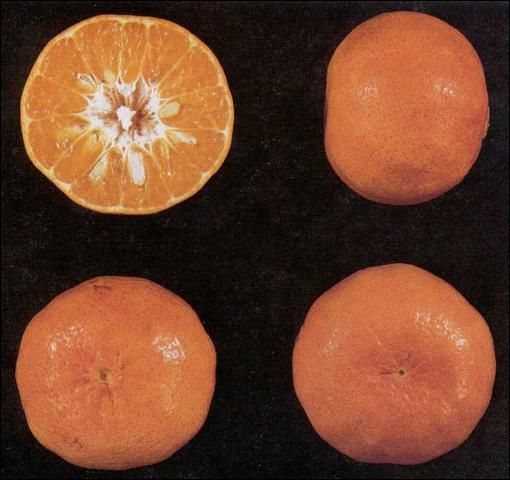The Robinson (Figure 1) is one of the released citrus hybrids originating from a Clementine x Orlando cross made by Gardner and Bellows at the United States Department of Agriculture Station in Orlando in 1942. It was officially released as a cultivar by Reece and Gardner in 1959. Since the fruit is 3/4 tangerine and 1/4 grapefruit, it looks most like a tangerine and is marketed as one even though it is technically a citrus hybrid.

Credit: UF/IFAS CREC
Fruit Characteristics
Robinson fruit is medium-large for a tangerine and fruit will average 2½-3 inches in diameter. The fruit shape is flattened, as is the case with most tangerines, and often has a small neck at the stem end. The rind is thin and leathery but easy to remove from the fruit. The rind is smooth, glossy, and deep yellowish orange at maturity. Seed content varies greatly and is dependent upon cross-pollination. Very few fruit will be set unless pollenizer trees such as Temple, Orlando, Sunburst, or Lee are in adequate number and arrangement within the grove. Fruit set where no pollenizers are present will be few-seeded, small, and very few in number. Nearby pollenizers will increase productivity, fruit size, and seed numbers with up to 20 or more seeds per fruit. The growth regulator gibberellic acid (GA) applied between full bloom and petal fall may increase fruit set and yields, but excessive fruit crops may be set in some instances.
Robinson is an early-maturing cultivar with harvest beginning in October and extending into December. The fruit will tend to dry out on trees with vigorous rootstocks or if held beyond peak maturity. Splitting of the thin-skinned fruit is often a problem.
Early harvest prior to color break which requires long degreening can result in postharvest decay problems.
Tree Characteristics
Robinson trees are upright and spreading in growth habit. The wood is brittle and with a large crop load, limb breakage can be a problem. The foliage is quite dense, and the trees appear rather bushy. Twig and limb dieback has been a continuing problem with this cultivar, but the malady has not proven to be fatal. Robinson as a scion is highly susceptible to Phytophthora foot rot. The tree is moderately cold-hardy but the thin-skinned fruit is not. Robinson should perform well on most commercial rootstocks but only those which would impart high quality to the fruit should be considered (avoid lemon types).
Cultivation
Once a fairly popular commercial variety, numerous production problems and newer varieties have caused a reduction in interest for Robinson cultivation. Some possible problems are noted below:
- Robinson is self-incompatible and must be planted in conjunction with other cultivars to assure good yields and large fruit size.
- Large crops on well-cared for trees may result in considerable limb breakage.
- Limb and twig dieback of an unknown origin is often a problem on Robinson trees.
- The thin-skinned fruit may be subject to problems of splitting at or near maturity.
- Care should be taken in selecting budwood as this scion is susceptible to xyloporosis. Xyloporosis-infected trees decline resulting in an economic loss within several years.
- Robinson does not produce sufficient pollen to effectively cross-pollinate a large number of Orlando, however Orlando will supply adequate pollen to work satisfactorily to cross-pollinate Robinson when the majority of the trees are Robinson.
More Information
Brown, H. D. and A. H. Krezdorn. 1969. "Hand Pollination Tests and Field Evaluation of Pollinators for Citrus." Proc. Fla. State Hort. Soc. 82:43-48.
Futch, S.H. and L.K. Jackson. 2021. Cross-Pollination Planting Plans. UF/IFAS HS170. https://edis.ifas.ufl.edu/publication/CH070
Futch, S.H. and L.K. Jackson. 2021. Pollination of Citrus Hybrids. UF/IFAS HS182. https://edis.ifas.ufl.edu/publication/CH082
Hearn, C. J. and D. J. Hutchison. 1977. "The Performance of Robinson and Page Citrus Hybrids on 10 Rootstocks." Proc. Fla. State Hort. Soc. 90:44-47.
Hearn, C. J. and P. C. Reece. 1967. "Pollination Needs of Page, Lee, Nova and Robinson Citrus Hybrids." Citrus Industry Magazine. 48(4):19,23.
Krezdorn, A. H. and H. D. Brown. 1970. "Increasing Yields of Minneola, Robinson and Osceola Varieties with Gibberellin Acid Sprays and Girdling." Proc. Fla. State Hort. Soc. 83:29-34.
Reece, P. C. and F. E. Gardner. 1959. "Robinson, Osceola and Lee — New Early-Maturing Citrus Hybrids." Proc. Fla. State Hort. Soc. 72:49-51.
Saunt, James. 2000. Citrus Varieties of the World. Sinclair International Limited. Norwich, England. pp. 72-73.